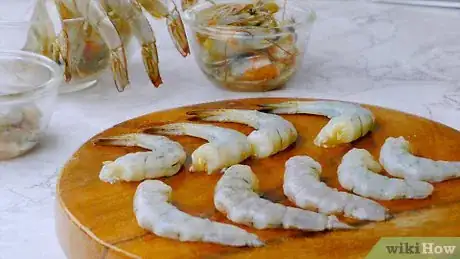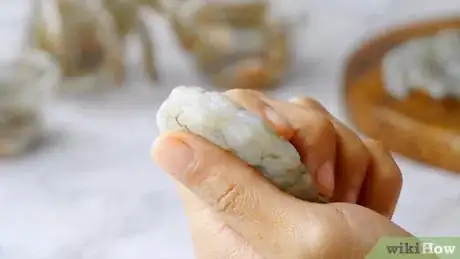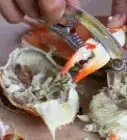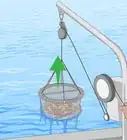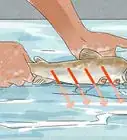This article was co-authored by Jennifer Levasseur. Chef Jennifer Levasseur is a Personal Chef and the Owner of The Happy Cuisiniere based in Breckenridge, Colorado. She has over 12 years of culinary experience and specializes in Mountain and Contemporary Rustic cuisine. Moreover, she can craft dishes and modify menus to accommodate dietary restrictions, such as gluten-free, vegetarian, vegan, pescatarian, and dairy-free diets. In addition to a Bachelor’s degree in Marketing and Management from the University of Houston, Chef Jennifer holds Associate’s degrees in Culinary Arts and Baking & Pastry Arts from Houston Community College.
wikiHow marks an article as reader-approved once it receives enough positive feedback. In this case, 100% of readers who voted found the article helpful, earning it our reader-approved status.
This article has been viewed 432,149 times.
Peeling and deveining shrimp is an easy step that can save you some money if you're willing to do it yourself. First, you remove the head, then pull off the legs and the shell. Devein shrimp with the help of a paring knife. Read on to learn more about how to peel and devein shrimp to get them ready to make into a tasty seafood dish.
Steps
Peeling Shrimp
-
1Decide whether to peel the shrimp before or after cooking. Many cooks maintain that keeping the shell on the shrimp during cooking enhances the flavor since the shell keeps juices in and is itself packed with flavor. However, some people like to peel the shrimp before cooking, so it's easier to eat the finished dish.
- If you want to keep the shell on the body while you're cooking it, but you'd rather not cook it with the legs and vein, use a pair of kitchen scissors to snip the shell along its back. This way you can still devein the shrimp, and peel off the shell when it's done cooking.
-
2Pull off the head. Sometimes shrimp comes with the head still attached. That's the first thing you should pull off. You can also chop it off if you'd rather.[1]Advertisement
-
3Pull off the legs. Grasp them between your fingers and pull them off in clumps. They should easily detach from the body.
-
4Pull off the shell. Start at the head end slip your fingers under the shell. Gently pull it away from the body in one piece.
-
5Leave the tail on or off - it's your choice. Some cooks like the way the tails look in the finished dish, while others prefer to remove it.
-
6Save the shells. Put them in a bag and freeze them for when you want to make shrimp stock. It's a delicious base for shrimp bisque and other seafood soups.
Deveining Shrimp
-
1Use a paring knife to make a slit along the shrimp's back. Cut in about 1⁄4 inch (0.6 cm). The flesh will peel open and reveal a black or white "vein" just beneath the surface — you don't need to cut too deep for this. This is the digestive tract of the shrimp - stomach and colon in all.[2]
-
2Use the end of the knife to lift the vein slightly. Start lifting it with your fingers.
-
3Pull the vein out gently with your fingers. Try to pull it out in one piece, so you don't end up with a lot of vein pieces. Use the knife to pry away any flesh that might be getting in the way. Discard the vein once you've pulled it out.
-
4Check the shrimp's belly. Some shrimp have a second vein on the belly side. If yours does, use the knife to make a second slit along the belly. Lift out the vein using the knife and your fingers.
-
5Rinse your fingers and the shrimp. The vein can be sticky, so make sure no bits get left behind.
-
6Keep the shrimp cold until you're ready to cook them. Shrimp deteriorate quickly in warm air, and they need to be kept cold. Put yours in the refrigerator or a bowl of ice water.
Using the Fork Technique
-
1Look for the beginning of the vein. Take a headless shrimp and look at the end where the head use to be attached for a little dark dot or vein just below the shell on the top side of the shrimp.
-
2Take a two tined cooking fork and put one of the tines directly on the dark spot or vein.
-
3Firmly hold the shrimp and start pushing the tine into the vein cavity. The shrimp will start straightening out as the tine goes down its spine. The pressure will split the spine and roll the shell back at the same time, peeling the shrimp and deveining it all at once.
- This method can be done with a shrimp deveining tool you can buy at seafood markets, but a two tined cooking fork will do the same job.
- Running cold water over the shrimp as you're forking it helps the vein come out and moves the process along more quickly.
Community Q&A
-
QuestionCan shrimp shells be eaten?
 Community AnswerYou can eat them, but they will not digest. If you have diverticulitis, it could cause issues, but other than that you would just poop them out.
Community AnswerYou can eat them, but they will not digest. If you have diverticulitis, it could cause issues, but other than that you would just poop them out. -
QuestionIf you don't remove the dark vein from the underside or belly of the shrimp, is that harmful? Should it be removed?
 Community AnswerThat's the tail of the shrimp, it is not harmful.
Community AnswerThat's the tail of the shrimp, it is not harmful. -
QuestionCan all shrimp be peeled and deveined or just certain kinds?
 Community AnswerYes. Every shrimp has a peelable shell.
Community AnswerYes. Every shrimp has a peelable shell.
References
About This Article
"To peel shrimp, first pull or cut off the head. Then, slip your fingers under the shell and gently pull it away from the body. If you want, you can pinch the tail and pull it away from the shrimp as well. To devein the shrimp, run a sharp paring knife along the back of the shrimp. Then, use your fingers to pull away the dark vein that’s just inside the flesh. Rinse the shrimp well.You can peel and devein shrimp either before or after you cook it, but leaving the shells on during cooking will enhance the flavor!"

